Recommended Varieties/Cultivars
Gardeners in California are fortunate to live in a climate where roses thrive in an astonishing array of colors, characteristics and uses. GardenZeus has done extensive research and consulted with local rose experts to make varietal recommendations by class, color and characteristics. For a complete list of our rose recommendations for your specific area enter your zip code.
Some of the standout varieties that perform well across many different areas of California include:
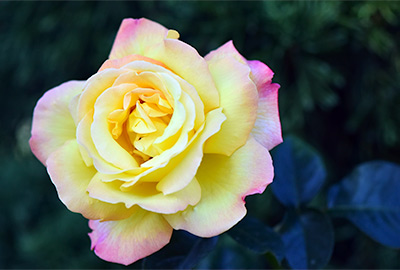
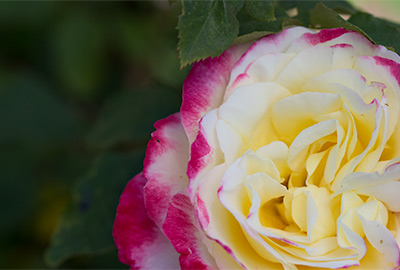
-Hybrid Teas and grandifloras: Recommended color-blends include Peace, the iconic pink and yellow blend and Double Delight® is a spectacular red-and-yellow blend. For a classically shaped fragrant white rose, look no further than Pope John Paul II. Frustrated peony lovers will want to grow Yves Piaget®, a dark pink ruffled peony look- alike. And Firefighter® is considered by many to be the perfect long-stemmed red rose.
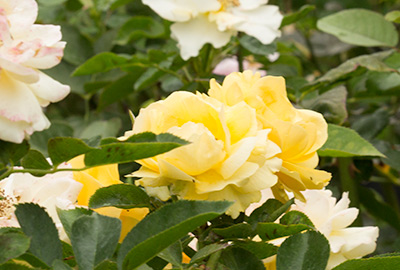
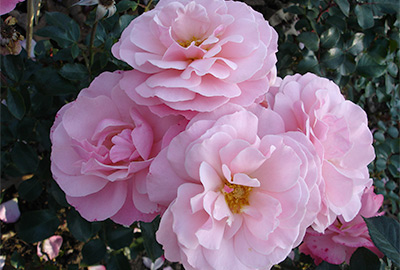
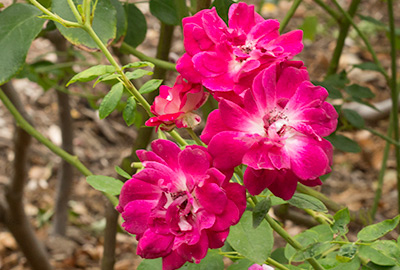
-Floribundas: Iceberg is the indomitable “go to” white floribunda and the creamy-white French Lace™ is widely considered one of the most beautiful roses. Excellent floribundas come in just about every color imaginable: Julia Child™ (yellow); Sexy Rexy® (pink); Showbiz (red); Burgundy Iceberg (deep red); and Hot Cocoa™ (Yes--brown!).
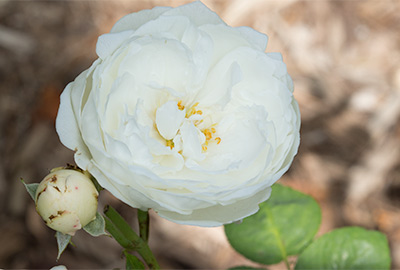
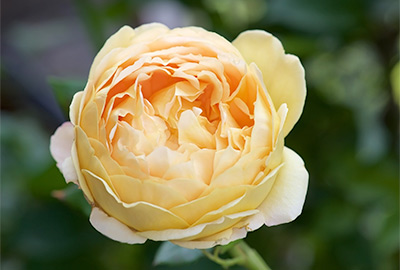
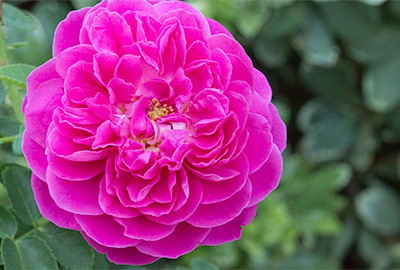
-Shrub roses, polyanthas, and rugosas: The Fairy is a standout polyantha that produces continuous small light-pink blossoms in large, profuse clusters. Outta the Blue™ is an incredible mauve shrub rose. For old- rose shaped blossoms and repeat blooming, several David Austen shrub roses do well, such as Fair Bianca® (white); Evelyn™ (pink-to- apricot); Golden Celebration™ (pale gold); Princess Anne (dark pink); and Tradescent (deep crimson). For a red rugosa hybrid, try Robusta.
Buying/Selection Tips
Select appropriate varieties for your area. Use special care when ordering roses by mail to be certain that they are appropriate. Bring sturdy gloves and eye protection to the nursery for safety, and wear long sleeves and long pants, to minimize thorn pricks on exposed skin when selecting, loading, and unloading. Roses may be purchased as either bareroot or container plants. Bareroot plants are generally available beginning in January, while container plants are available at many nurseries in most portions of California year-round. Many of the less common varieties may be available only as bareroot plants.
When selecting bareroot plants, nick the bark near the end of a stem to confirm that the cambium is still green and alive. If the tips of stems are dead, make a tiny nick lower down on a stem. If you are unable to find green, living cambium, the plant may be dead and should not be purchased. GardenZeus recommends caution with buying bareroot roses after early March; be sure to confirm that plants were received recently by the nursery.
If buying a container plant, bring gloves to the nursery. Hold the plant firmly at the based of the main stem, lift a few inches off the ground, and tap the edge of the nursery pot to loosen it and look at roots. Ideally you will see a few light-colored roots at the edges of the root ball. If you see thick growth of roots at the edges of the rootball, circling roots, or thick matted roots, the plant may have been potted for longer than is desirable; GardenZeus recommends selecting a different plant.
Soil Needs/Tip
Roses prefer a well-drained, loamy soil that is rich in organic matter. This can take years to develop in many of California's compacted clay soils and hillside decomposed-granite soils; begin by surface-dressing soils after planting (see Planting Method/Tips). Most rose species prefer a pH of 6.0 to 7.0. Roses tolerate insufficient acidity and even slight alkalinity better than many other popular flowering perennials.
Suitable Microclimate
Most rose varieties need full sun, at least 5 hours of direct sun per day, with 7 or more hours of sunlight being ideal during active growing and blooming periods. When receiving less sunlight, many roses will be unreliable or sporadic with blooming, and may become leggy. Varieties that are not heat tolerant will suffer and may become prone to diseases and pest infestation in direct sun in during summer, or may die from diseases or pest infestation as a result of being stressed by heat.
Getting Started
GardenZeus recommends looking at, and if fragrance is important, smelling, actual rose flowers of varieties you are considering for planting. This may require multiple visits to nurseries, botanic gardens, and private gardens before plants are purchased. When starting a new rose garden or preparing to plant new rose varieties, allow yourself a few weeks or months to engage in the delightful research of viewing dozens of rose varieties in local gardens, and to find varieties that you not only like, but that you truly adore. Most roses require significant maintenance and seasonal care, and before committing yourself to this, GardenZeus recommends selecting varieties that you will look forward to caring for and enjoying over many years. In many portions of California, some rose varieties have long blooming seasons or may bloom almost year-round.
Watering Tips
While many species of roses will survive on little water once established, most roses need regular watering to bloom abundantly. Water new plantings frequently, once or twice per week in cool weather, two or three times per week during warm weather, and as often as every day or every other day during hot weather. Most established roses will need watering every week or two before and during blooming periods or during hot weather to produce flowers regularly. Water roses as deeply and infrequently as possible to encourage deep rooting, which will help minimize pest and disease problems, and help roses to tolerate summer heat.
Planting Method/Tips
Keep the rootballs of bareroot plants moist from the time purchased or received and soak roots in a bucket of chlorine-free water for a few hours before planting. Roses purchased in containers should be well watered, then allowed to drain overnight before planting.
Plan placement to avoid roses shading each other or being shaded by other plants or buildings; in may cases, a pair of staggered rows works well, with a walkway of ample width on each side for care and pruning. Use eye protection and wear sturdy gloves, long sleeves, and long pants for safety and to minimize thorn pricks to exposed skin when planting roses.
When planting from containers, remove the plant from the container and gently remove excess soil at the top and bottom of the root ball. Whenever possible, prevent soil from falling entirely off the rootball, as this may shock or kill the plant. Roses should be planted with the root crown and the highest root at or slightly above grade, in a hole no deeper than each plant's actual rootball. Do not dig a hole deeper than the rose plant's rootball or disturb soil at the bottom of the hole, as the plant may sink below grade when loose soil beneath roots settles over time, which may result in lifelong stress and ongoing pest and disease problems for the life of the rose plant. Before planting, prune out any dead or broken stems, and cut off girdling, circling, matted, or dead roots, leaving roots that can be spread with a few inches of spacing between them in the planting hole. Many bareroot roses will have been root-pruned prior to sale. Take a close look at roots and prune out those damaged in transport, crossing, or those that cannot be spread or spaced in the planting hole.
GardenZeus recommends adding no organic matter or amendments to planting holes for roses, and instead surface-dressing with compost, composted manures, mulch, and amendments based upon soil-test data, to encourage a healthy soil ecosystem and to require the plant to grow roots beyond the planting hole to meet its needs for nutrients, and therefore establish a healthy root system. When amendments and organic matter is added to planting holes, roses often grow a smaller root system within the richer soil of the planting hole, which is undesirable and may lead to various problems, including less flowering, over the life of the plant. Water thoroughly after planting.
Spacing
Rose spacing varies widely by growth habit and type of rose, and is best determined by for exact varieties being planted and the individual gardener's preferences and needs. Thoughtful spacing is more important for roses than many other flowering perennials, to allow individual plants sufficient sunlight and root space to produce blooms, to allow the plants to display their flowers in the manner desired (such as without crowding for shrub and hybrid tea roses, and in mass displays for climbers), to allow for air circulation to minimize foliar diseases (especially in humid and warm climates), and to allow a gardener space for pruning and tending of roses without having to pose awkwardly or be pricked by thorns. Placement and spacing is especially important near walkways, pools, seating areas, parking spaces, doorways, and play areas, to avoid risking unexpected scratches or frustratingly frequent pruning to maintain usability of these spaces. Spacing and placement of roses can be a complex topic and require careful planning, and is an area in which it can be well worth hiring a skilled consultant or designer who knows roses well. GardenZeus generally recommends 14 to 18 inches for most miniature roses, 2.5 feet for most floribundas, 3 feet for most hybrid tea roses and grandifloras, 3.5 to 4 feet for most shrub and landscape roses, and 7 to 10 feet for most climbers. Spacing for groundcover roses will vary by variety and growing conditions, often 2 to 4 feet.
Timelines
With sufficient water, nutrients, and proper care, many rose varieties will bloom within 1 to 3 months of planting (both container and bareroot plants). If you want blooms quickly, be sure to plant varieties that are known to do so quickly in your zone. Particularly when planting in spring, GardenZeus recommends cutting off rosebuds for several months to encourage new plants to put energy into vegetative growth and establishing root systems.
Pollination Needs/Tips
Most gardeners are primarily interested in rose flowers, so pollination is usually not a concern. Gardeners may appreciate that roses provide food for bees and other beneficial insects. Dedicated enthusiasts and hobbyist may grow roses from seeds, particularly in order to hybridize and develop new varieties. From seed in the home garden, some varieties of roses may bloom within the first growing season; most will take 1 to 3 years.
Interplanting/Companion Planting
Adding plant companions for roses is a design art unto itself, and may depend on many factors, from the type and growth habit of the rose to its bloom color and the preferences and habits of the gardener. It's important to choose companion plants with similar or compatible needs for soil, watering, and sunlight, and that will not become invasive at your site under the growing conditions needed by roses. Traditional companions for roses include alliums such as garlic and onions for discouraging pests; low-growing monocots and ornamental grasses, especially in colors that compliment or contrast with specific rose bloom colors; annual and perennial flowering plants that provide complimentary or contrasting foliage shape or color, flower shape and color, or other aesthetic effect; and herbs such as sage and lavender.
Nutrient/Amendment/Fertilization Needs/Tips
Established roses of any variety in fertile soil with a thriving soil ecosystem may need little or no supplemental fertilization to provide abundant blooms. Species and heritage roses also may need little fertilization. Most modern roses will produce the largest, most frequent, and most numerous blooms if they receive supplemental fertilizer. Roses are often fertilized as soon as the first flush of new growth is seen in late winter in your zone, then fertilized again at the end of each bloom cycle after spent blooms are removed and as the plant sets, grows, and opens new buds. While rose hobbyists and enthusiasts may fertilize with every bloom cycle to maximize frequency, size, and number of flowers, it is not necessary to fertilize regularly for rose plants to bloom and be healthy, and many gardeners and rose lovers may prefer not to adhere to any frequent or formal schedule of fertilization.
Nutrient and fertilization needs vary widely among rose varieties and species; know your soil, the nutrients it is lacking and has in abundance, and the nutrient needs of your rose varieties and species. Most roses will perform best with supplemental nitrogen during active growth and blooming; this is the one nutrient that is most commonly lacking in otherwise reasonably healthy and fertile soils. Many soils in California have high levels of phosphorous and potassium, so these nutrients may not be needed in chemical soluble form unless your soil pH is alkaline, and you may do better for your roses and save money over time by encouraging a healthy ecosystem in your soil that can provide these nutrients to plants rather than simply adding soluble chemical fertilizers.
Many chemical and inorganic forms of rose fertilizer are readily available. For organic, ecofriendly rose fertilizer, GardenZeus recommends 1/4 to 1/2 cup of uncomposted chicken manure mixed well into 3 to 4 gallons of water and applied after watering as a soil drench every 10 to 14 days or on the same intervals you would othewise apply chemical fertilizers during periods of bloom. In soils with pH below 7.0 and sufficient phosphorous and potassium, urea only may be sufficient as fertilizer during blooming periods. As with chemical fertilizers, chicken manure and other organic fertilizers, particularly those high in nitrogen, can cause salt burn to rose plants, so use judiciously, be patient, and allow plants to show a growth response over at least several days to a week before considering a new application of fertilizer. In soils with low levels of magnesium and/or sulpher, roses will benefit from occasional application of Epsom Salts, about 1/4 to 1/3 cup per plant dissolved in chlorine-free water and applied to the root zone after watering.
In hot summer areas, GardenZeus recommends against fertilizing most roses before after early summer to avoid producing growth spurts during summer heat. For rose varieties that go dormant or semi-dormant, GardenZeus recommends discontinuing all fertilization about 2 months before the dormancy period begins.
Mulching
Roses generally benefit from a year-round layer of mulch to retain moisture, inhibit weeds, feed the soil, and moderate soil temperature. When possible, mulch with spent rose blooms and pruned leaves to return necessary nutrients to the soil for future growth and blooming, preferably by placing these high-value forms of organic matter under other mulch to conserve nutrients from the rose's own leaves and flowers, and speed their decomposition and return to soil. For established plants, maintain a 2-inch thick medium to coarse mulch of wood chips, pine needles, leaves, or similar materials, keeping soil bare and clear of mulch in a radius of several inches from the stem of each rose. For new plantings, add 1 to 2 inches of fine to medium mulch of sawdust, fine organic matter, straw, or pine needles, keeping soil bare and clear of mulch in a radius of 4 to 6 inches from the stem of each rose. Do not apply mulch near stems of rose plants as this may concentrate moisture and pathogens against the stem of the rose and encourage root rots and other diseases.
Pruning/Cutting Back/Pinching/Separating
Pruning and training of roses varies by type and species, and can seem complicated and overwhelming, especially to new gardeners or those not specifically experienced with roses. The basics that apply to all roses include sterilizing tools between plants, using sharp pruners, removing suckers, and the method of making cuts.
Use sharp pruning shears and other tools, which may require sharpening about every 15 minutes to an hour, depending upon how rapidly you cut, the quality of the tool blade, and how well preserved the blade's bevel has been after prior sharpening.
Remove suckers and watersprouts, which are growths from the rose rootstock or stem at or below the plant's graft. Many rose varieties are actually two plants, a rootstock and a scion, that are grafted and grown together as one plant to be sold by nurseries. To preserve the scion with its desirable blooms, all leafing growth from below the graft should be removed regularly or as needed multiple times per year. Suckers and watersprouts are often readily identifiable because stem color, thorn size, growth habit, or other characteristics differ obviously from the desirable blooming wood.
Make cuts at an angle slightly above a bud or node that naturally points in a desireable direction for new growth and blooming, with the cut pointing in the direction of the bud or node. Roses transport nutrients and fluids across stems, so be sure not to cut below the top of any bud or noe, as this might inhibit the plant's ability to produce strong, rapid growth, and might produce new stems that are weakly attached and prone to breakage.
While rose pruning will vary by type and species, many roses need two primary kinds of pruning. The first is clean-up and light pruning after blooming. The purpose of this is to remove spent blooms to prevent the rose from putting its energy into producing seeds (and therefore slowing production of the next round of blooms), to clean out any spent or dead canes, and to train minimally as needed for the next round of blooming. The second kind of basic pruning is annual shaping, which is normally done while roses are dormant, in early winter through late winter, although many roses tolerate aggressive pruning while in full leaf. The annual-shaping pruning requires more skill and experience than cleanup of spent blooms and between periods of blooming, and full instructions are beyond the scope of this section of GardenZeus. Pay careful attention to direction of buds and nodes to shape the plant's growth for the coming season and year. In the case of roses that have been cut back severely to reshape, and in many other instances, semi-annual or more frequent pruning may be required for proper shaping.
Propagating
Most modern roses are propagated by grafting, particularly bud grafting. GardenZeus recommends against propagating these roses, including hybrid tea roses, with cuttings or layering, as the propagated plants are unlikely to develop the strong root systems, general vigor, and blooming ability of the grafted plants, and for the time spent, potentially many hours over months to years, it is almost certainly more efficient and a better value to graft yourself or to simply purchase nursery stock. Heritage and species roses may be propagated through cuttings and layering.
For propagating roses in most portions of California via cuttings, GardenZeus recommends taking numerous cuttings of recent-growth rose stems that are about the diameter of a pencil or smaller and about 8 to 10 inches in length, with a green color to the stems, and with at least 4 to 6 nodes per cutting. Remove all but one small leaf, or half of a larger leaf, at the top of the cutting. Place many cuttings into a single 1-gallon pot, up to 20 cuttings in one pot, in sand and/or vermiculite as a growing medium, with at least 2 nodes on each cutting below the pot's soil level and buried in the rooting medium, and at least 2 nodes on the stem for leafing. Cover cuttings with a plastic bag and make a few small air holes in the sides (not top) of the bag so that air stays humid around the cuttings but there is still air circulation. Keep the cuttings in a bright area that stays out of direct sunlight during warm-but-not-hot periods of the year.
GardenZeus considers the effectiveness of rooting hormones, such as Rotenone, to be unproven, and considers them unnecessary for propagating rose cuttings. Keep the sand/vermiculite rooting medium moist but not wet. Watch for growth of tiny new leaves on rose cuttings, which often indicates successful rooting. Remove any flower buds from newly rooted cuttings. Expect about 5% to 10% success with rooting rose cuttings, which means that for a single one-gallon pot containing 20 cuttings, you may have 1 or 2 cuttings that root successfully. A record of 25% or more in rooting cuttings usually indicates either skill on the part of the gardener, luck, or a rose variety that roots easily.
Container Gardening
Most roses grow well in containers as long as root space is sufficient and care is appropriate. Containers of at least 2 to 2.5 feet in depth and at least 15 to 20 inches in diameter are recommended for full-sized rose varieties, and generally the deeper the better for rose health, growth, and blooming. Roses planted in pots and containers generally do not grow as large as those planted in the ground; 4-to-6-feet-tall plants may be the maximum reasonable size range for roses in all but the largest containers.
Large rose varieties, including many climbers and shrub roses, generally should not be grown in containers but may perform reasonably well in large containers or planters of 2.5 to 4 feet in depth.
Container roses should be placed in a location receiving a minimum of six hours of sun. Clay pots will help to keep rose roots cool during hot summers, but clay and terra cotta tend to wick moisture from soil and therefore require more watering than their plastic counterparts..
When planting roses in containers, be sure that sufficient soil is added to completely cover roots to the root crown. Mound soil slightly and monitor over the next few weeks and months to be sure that soil levels do not settle sufficiently to expose roots.
A number of challenges arise when growing woody perennials, such as roses, in pots or anywhere root space is limited:
1) Root binding: It is inevitable with most potted roses that roots will outgrow the available soil and space. Root binding will cause many roses, and particularly those in smaller pots, to decline within a few to several years as roots circle, girdle, exhaust available nutrients, and become so densely packed inside pots that water and nutrients may not penetrate rate. Root binding is a common cause of stress, disease, pest infestation, and death in potted roses.
To keep roses alive and healthy indefinitely in pots, they must be moved to a larger pot with fresh soil about every 2 to 4 years; or removed in about the same time frame and carefully root pruned during a time of year when the plants are dormant or semi-dormant and not blooming, and when weather isn't hot, then returned to the same pot with fresh, nutrient-rich soil.
2) Salt burn: Minerals are added to most municipal water to prevent corrosion and extend the life of water pipes. When potted trees and plants are watered with city water, such as that coming in through landscape hoses, irrigation systems, or house faucets, some of the water evaporates, leaving minerals behind in the potted soil that tend to build up and become toxic to plants. The damage from this typically appears as dead, brown leaf edges and/or tips, which may extend to cover most or all of a leaf's surface, and if allowed to persist and worsen, this will eventually kill almost any potted plant or tree.
To address salt burn, soil in pots must be flushed periodically to dissolve and remove mineral build-up. This can be accomplished by leaving a potted plant outdoors all day in rain for a few days per year; or by soaking potted plants in fresh water (municipal or otherwise) for a few hours, such as in a large bucket or tub filled with water up to the brim of the pot, then flushed by running water through the potted soil for several minutes. Roses grown in pots under eaves or in areas protected from natural rainfall generally need to be flushed at least twice per year to avoid salt burn.
3) Anaerobic soil: Water becomes trapped in pots with poor drainage, and once oxygen in the water is depleted, anaerobic organisms multiply and produce foul-smelling byproducts that are toxic to plants. This may occur in pots or beneath the soil surface in poorly drained landscapes. Pots should have large holes in the bottoms to allow for good drainage. Drainage may be improved and anaerobic conditions reduced by including gravel in the bottom of containers, especially in deep containers.
4) Soil dryness: Soil in pots may tend to dry quickly, and roses in containers may need much more frequent watering than those planted directly in the ground. Watch for rose leaves curling inward or wilting slightly and be diligent in avoiding significant wilting. Container roses may need daily watering during warm weather, and in some cases even twice a day during heat waves, particularly when in proportionately smaller pots or when their roots are not connected into the larger soil ecosystem in the soil beneath pots.
5) Nutrient exhaustion: The limited volume of soil in pots becomes exhausted and leached over months and years. Maintain surface dressing of compost and amendments under mulch for potted roses, and consider using slow-release organic fertilizers if your potted perennials show nutrient deficiencies.
Miniature roses are particularly well-suited to containers. As always, be careful when making your selections: miniature roses often come in small pots and have small leaves and flowers, but this can be misleading as an indication of eventual plant size. Mini roses may grow to over 3 feet in height and become too large for the space or container originally selected. Gourmet Popcorn, with white with creamy yellow centers, is an example of an attractive miniature variety for containers.
“Miniflora” roses are larger than miniatures and are bred specifically for rose shows. They tend to have ungainly structures that don’t work well in containers, or in most garden settings.
Resist the temptation to purchase for garden use the cute or inspiringly lovely potted miniature roses you might see in the grocery store checkout line or in other impulse-sale areas: these roses may not be suitable for your climate and growing conditions. GardenZeus recommends purchasing known rose varieties that are suitable for your zone from a reputable nursery or mail order source.
Roses are heavy feeders and container roses may need more frequent applications of nitrogen, amendments, and/or fertilizer than their in-ground counterparts. (See “Nutrient/Amendment/Fertilization Needs/Tips” in the GardenZeus section “Planting and Maintaining” for more information on fertilizing roses.)
Roses in containers will generally be grow most successfully when they aren't competing for root space with too many other plants. While attractive groupings of roses, perennials and annuals are possible, be judicious about crowding roses in containers. Possible companions for container roses include alyssum; low-growing monocots; and small, well-behaved ornamental grasses, especially in colors that compliment or contrast with your specific rose bloom colors.
GardenZeus Tips for Container Gardening:
- Containers allow you to move plants to follow seasonal changes in sun, to shaded areas during heat waves, to warmer areas during winter, and to protected areas when necessary in response to winds or other environmental factors.
- GardenZeus recommends a soil mix of at least 2/3 to 3/4 combined sand and topsoil when growing roses in containers, with some organic matter or compost. You may wish to add small amounts of various organic amendments as needed, particularly after testing the mineral composition of your soil. Potting soils with high proportions of organic matter tend to shrink and collapse over the course of a growing season as soil microbes and macro organisms like insects digest or decompose the organic matter, which results in falling soil levels that may cause stress to roses, expose their roots, and predispose them to pest infestation, disease, and poor blooming.
- Container plants are more sensitive to drying soil, especially in warm weather, which can reduce bloom quality, shorten the bloom period, and lead to many other problems for roses. Soils may dry rapidly in containers, so monitoring and regular watering in containers is important. Pay close attention to soil moisture and frequency of irrigation, and be sure to water sufficiently to avoid any signs of wilting.
- If you know you may have difficulty maintaining consistent soil moisture, consider using self-watering containers, which have a reservoir of water and a wicking mechanism, such as cloth or soil tubes. These can be purchased or made yourself.
Seasonal Care
Many roses bloom almost continuously from late winter through late fall in many portions of California. Provide sufficient organic or inorganic fertilizer during active blooming periods. Prune for cleanup and deadheading as needed. Annual pruning of most rose varieties for form is typically completed in December and January in areas of California with moderate winters.
How to Harvest
Using clean, sharp pruning shears or scissors, snip blooms as needed and to the length possible or desired. Take a moment after cutting blooms to snip the tips off of all thorns with pruners or scissors, and to complete an angled pruning cut at a desirable bud or node.
Harvesting Tips
Cutting the stem of rose flowers at an angle creates a larger surface area for the cut stem to absorb water.
What Commonly Goes Wrong
Legginess: Roses that are grown in partial shade or without sufficient sunlight often develop long, straight-upward stems with few or no leaves. Pruning these often simply results in another attempt by the rose to grow new upward stems in its attempt to reach sunlight. Roses with insufficient sun will produce fewer or no blooms, and are often impossible to prune into a pleasing form.
Overgrowth and dense growth: Many rose varieties grow aggressively, especially when fertilized, and especially when neglected or as the result of unskilled pruning, can become a tangle mass of dense and crossing branches. Learn proper methods for pruning roses and expect to spend hours rather than minutes, in some cases with multiple pruning sessions over months to years, to clean out such tangled growth and restore a more open branching structure and pleasing form.
Yellowing, poor growth, general sickly appearance: These common symptoms may result from overwatering, underwatering, cold weather, compacted soil, alkaline soil, lack of nitrogen, or lack of a key soil nutrient. Varieties of roses that are inappropriate for your climate or site conditions may be persistently unhealthy. These symptoms may also be the result of too little sun, hot temperatures, wind, or other environmental and abiotic factors.
Few or no blooms: Usually cause by too little sun, lack of key nutrients in soil, compacted soil or other soil issues, or inappropriate variety of rose for your climate and site conditions.
Not a Problem
Mosaic Viruses: Mosaic and other viruses often occur in roses. In some cases they may cause few or no symptoms and go entirely undetected. Mosaic viruses may cause odd leaf symptoms, such as yellowing, mottling, blotchiness, or odd wavy or banded lines, or rings on rose leaves. Leaves may also be curled, twisted, puckers, or otherwise different than healthy leaves. While these viruses can harm plants, it is rare for them to be a significant issue. Severity and expression of symptoms varies widely by rose variety. Hot summer weather often inhibits rose viruses such that leaf growth may be more normal during and after hot weather, with abnormal leaves often returning during cooler weather. The control or elimination of such viruses is difficult to impossible in home landscapes, and most portions of Californai, mosaic and most other rose viruses are not a significant threat to the health and life of the plant.
Dieback after blooming: Spent blooms may die back to a stem node. A rose covered in such old, spend blooms, with sections of brown, dead stem may appear unhealthy, and inexperienced gardeners may even believe that a rose plant is sick or dead when viewing a normal plant with spent blooms. Green leaves and stems usually indicate a healthy rose plan. Dormant roses without leaves may also appear dead; nick a small upper stem to find green cambium, and proceed down to nicking lower stems when live cambium is not found.
Common Diseases
Roses suffer from a large number of diseases, some of which have similar symptoms and may be difficult to diagnose. The most common diseases of roses generally are not fatal and plants often tolerate them over years while still blooming abundantly.
Rose Rust: Small clumps or pustules of dusty or powdery-appearing fungal growth on the undersides of leaves. Upper leaf surfaces may be blotchy yellow or black, and for severely infected leaves, turn yellow or die. Rose rust tends to proliferate during cool, wet weather, but may also be present during warm, dry weather. Avoid wetting foliage when watering. Rust can be discouraged using a nontoxic homemade spray of one tablespoon each of baking soda and tea tree oil per quart of water, shaken vigorously and regularly as applied via spray bottle. Some degree of rust is often present in roses in many portions of California, and is difficult to control completely. Removal of severely infected leaves may improve a plant's appearance, but does not provide effective control. Rust is best managed through prevention and good cultural practices such as planting resistant varieties, planting with enough spacing for good air circulation, keeping foliage dry, less-frequent irrigation, and encouraging biologically active "living" soil that will support strong plant immune systems. Rust is usually not fatal and roses may produce abundant blooms despite ongoing infections.
Mildews: Powdery and downy mildew appear as whitish circles or whitish layers on the upper or lower surfaces of leaves, yellowing or dead spots, or pale or yellow angular leaf sections, and may be mistaken for other problems, such as nutrient deficiencies. Avoid wetting foliage when watering. Some mildews can be discouraged using a nontoxic homemade spray of one tablespoon each of baking soda and tea tree oil per quart of water, shaken vigorously and regularly as applied via spray bottle. Mildews are often difficult to control and are best managed through prevention and good cultural practices such as planting resistant varieties, planting with enough spacing for good air circulation, keeping foliage dry, less-frequent irrigation, and encouraging biologically active "living" soil that will support strong plant immune systems. Mildews are often not fatal and roses may produce abundant blooms despite ongoing infections.
Common Pests
Common pests in your area include aphids, spider mites, mealybugs, scale, caterpillars, and roseslugs.
Special Care
GardenZeus recommends thoughtful selection of protective clothing and gear for pruning roses, which at minimum should include eye protection, sturdy gloves, and long pants and sleeves. Little thorn scratches add up and can be surprisingly painful. Even thick fabric and long sleeves aren't quite enough to prevent thorn pricks, many fabrics tear more easily than you might expect when caught accidentally on a thorn. The condition of many gardeners' hands and arms after a pruning session may leave them wondering which lost more flesh, the rose or the gardener. Consider purchasing rose gauntlet gloves for extra protection when pruning roses, especially if you have a large number of plants or prune regularly.
Special Info
Rose hips are the fruit of roses. Some varieties of roses are grown specifically for their ornamental hips, and others seldom or never produce hips.
Sustainable Landscaping Tip
Rosa californica is a native rose species that tolerates heavy soils in many portions of California, and both survives and blooms on much less water than most non-native species. It may suffer in summer, and do best with partial shade during the heat of summer. It provides habitat and food for native bird and insect species. It grows into dense clumps and is suitable for mass planting. While drought-tolerant, it prefers and will bloom better with some summer water. It prefers more fertility than many California landscape natives.
Advanced Tip
Plant roses in ones and twos throughout your garden and landscape rather than in masses or rows. This helps reduce pest and disease problems, and can have other benefits, such as attracting pollinators to vegetable patches.
GardenZeus expert Darren Butler appreciates roses as much for their ability to discourage mammalian pests as for their blooms and fragrance. He considers rose canes the best solution to many small-area garden pest problems such as grazing by wild bunnies, cats using beds or pots as litter boxes, digging by raccoons, and similar mammalian pest issues. Cut thorned rose canes and lay them in a protective barrier with thorns facing upward in beds and pots or around plants when protection is needed. Be sure to alert all people gardening or using the area, especially those harvesting or watering by hand, and avoid using rose canes in areas that are accessible to children. Do not use rose canes near a play area or an area where people walk. For many mammals, one or two paw pricks is all that is needed for them to abandon your plant or raised bed and move on to easier pickings. Refresh canes and adjust placement as needed. GardenZeus does not like causing pain to any animal, but we prefer the sometimes magic solution of thorned rose canes to the poison and other kill methods that are often resorted to with mammalian pests. Note that GardenZeus emphatically does not recommend rose canes for discouragement of dogs under any circumstances, because with their romping and rambunctious activity, dogs may less capable than cats and wild animals of recognizing areas that are unsafe for their paws. Cats get it immediately, as do wild animals. Viva la bunny!
Preservation, Storage, and Use
To maximize the life of cut roses, place rose stems under water and re-cut at an angle. Remove foliage that will be below the water line once in the vase.
To extend the life of rose bloom in vases, add 1 to 2 tablespoons of sugar to vase water. GardenZeus also recommends adding a small amount of vinegar to inhibit bacterial growth in vase water, not more than 1 to 2 teaspoons, and changing vase water every 1 to 3 days.
Keep roses away from fruit that may be sitting on your counter. Most fruits give off ethylene gas and the exposure to the gas will cause roses to deteriorate more quickly.
Rose hips are the fruit of roses. They are high in vitamin C, contain the antioxidant lycopene, are generally considered edible, and can be used to make bread, syrup, jams and jellies, wine, and other foods and beverages. Both rose petals and rose hips are used for herbal teas. To make rose hip tea, place two teaspoons of rose hips in one cup of hot water and steep for ten minutes.
Rose petals can be placed in bath water, or dried for potpourri and sachets. Or, scatter fresh rose petals around candles on your table for an attractive centerpiece.